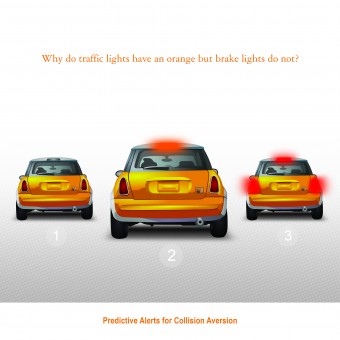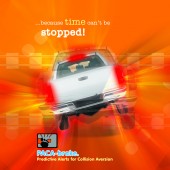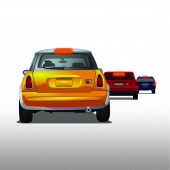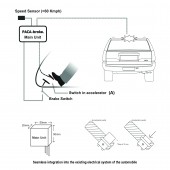Saving Millions of Lives on the road! Concept Warning System by Anjan Cariappa M M |
Home > Winners > #25198 |
 |
|
||||
| DESIGN DETAILS | |||||
| DESIGN NAME: Saving Millions of Lives on the road! PRIMARY FUNCTION: Concept Warning System INSPIRATION: Why do traffic lights have an orange but automobile brake lights do not? Food for thought! UNIQUE PROPERTIES / PROJECT DESCRIPTION: PACA is a paradigm shift from conventional design language rather than a hardware system. A life threatening flaw in a long existing design is corrected using PACA. All automobiles come only with red brake lights at the rear. This warning system has limitations because the red warning light is displayed only AFTER the driver hits the brakes. Reaction times to this red light by drivers following the braking vehicle is not sufficient thus leading to collisions and a possible pile up especially at higher speeds (Please refer to graph included). PACA-brake displays a prior warning orange blinking light on the third brake light (CHMSL) when the driver in the lead vehicle even considers slowing down his/her vehicle and before s/he actually hits the brakes. This in turn gives precious time for the driver behind to react and thus prevent a collision. The blinking is incorporated in the warning so that persons with Colour Vision Deficiency can read the warning. OPERATION / FLOW / INTERACTION: The sheer strength of PACA-brake is its simplicity. A driver driving any standard motor vehicle moves away his/her foot from the accelerator pedal only when he/she would want to brake or a braking situation is anticipated. Otherwise it is almost always rested on the accelerator pedal. Even when coasting, the foot only eases on the pedal and is not taken off it. A switch in the accelerator pedal helps to monitor this foot position. PACA-brake displays the prior braking warning in the form of orange blinking lights when the driver takes his/her foot off the pedal rather than displaying only a brake light when the brake pedal is depressed. The warning continues until either the brake pedal is depressed or the accelerator pedal is pressed again. The warning display also comes on when the brakes are released and continues until either the brake pedal is pressed again or the accelerator pedal is depressed. This is to warn of the automobile’s slowing down. PACA-Brake can be handy in other ways. When a driver feels that a vehicle is tailgating his/her vehicle, the blinking lights can be triggered voluntarily to warn the driver behind. By default, PACA-brake displays the warning once the vehicle exceeds 60 Kilometres per hour. However, national and International Safety experts and authorities can fix standard speed parameters under which PACA-brake can be set to display the warning. Who will benefit? Firstly the road users, public and world citizens since this active safety system is capable of preventing road accidents and thus save millions of lives every year. Second are the manufacturers of the product such as OEMs who can look at a world market for this improved product. The product has the potential to become a mandatory device and thus target EVERY AUTOMOBILE on the planet. Automobile manufacturers can leverage the sale of their products banking on the need for better safety measures demanded by today's buyers. Down the value chain are other entities such as Insurance companies who would benefit from the prevention of collisions and thus litigation, lesser deployment of precious resources such as police forces, paramedics, legal services and necessary infrastructure for the aid of these road accidents. Details of PACA-brake can be viewed here: http://muckati.com/p PROJECT DURATION AND LOCATION: The project was conceived in 2009. We are in talks with various safety bodies, auto makers and OEMs around the world. The system was showcased at the "International Transport Forum" at Leipzig Germany in 2010. The system received fabulous reviews from policy makers and auto manufacturers alike. FITS BEST INTO CATEGORY: Office Furniture Design |
PRODUCTION / REALIZATION TECHNOLOGY: It has to be first considered that PACA-brake is more of a radical design idea than a physical system. It can be built in various configurations to give the same result. In hardware form, it is a micro-controller based system and is designed to be integrated seamlessly into the existing circuitry of an automobile during manufacture or as an aftermarket fitment. The design incorporates dual-color LEDs (Red and Orange) in the CHMSL (Third Brake Light) housing. Thus special tooling and redesign to the existing CHMSL design of the automobile is not required. Wire harnesses, cables and their routing in the car remain unchanged. SPECIFICATIONS / TECHNICAL PROPERTIES: The dimensions of the packaged unit is approximately 50 mm X 20 mm X 50 mm and the casing is made out of heat resistant plastic. To do away with triviality to the warning in slow and stop and go traffic, the system arms itself only after the vehicle reaches a certain speed. By default, this is programmed at 60 kmph. However, national and International Safety experts and authorities can fix standard speed parameters under which PACA-brake can be set to display the warning. PACA-brake is future proof such that its relevance will not become obsolete even if automobiles change over to electric, alternate fuels, hybrids etc since the operation remains the same. The throttle and brake pedals will remain into the future in all probability. 1.PACA-brake has the potential to become a mandatory system in ALL vehicles akin to the seat belt. Mission is to reach every automobile on the planet. 2.Active safety system: Prevention better than cure (Most safety systems are passive viz: Seat belt, airbag, crumple zones etc') This simple innovation has been overlooked by automakers around the world who have been too obsessed with technology and cost intensive research and development. In all the advancement of distance sensing radars and high tech sensors at the cost of millions of dollars, these researchers ironically have forgotten the existence of an intelligent being in the automobile known as the human driver. Simplicity and Effectiveness of PACA-brake translates to... Easy installation in all automobiles Easy integration into existing circuitry No major changes to design of automobile or its electrical system TAGS: Highway, Road, Automobile, Car, Safety, Traffic, Accidents, brake, health, people, Save, Collision, family RESEARCH ABSTRACT: Various studies are being conducted to further prove the effectiveness of PACA-brake. Apart from the study using a virtual simulator in which the effectiveness of PACA-brake was proven beyond doubt, a different group of test subjects were shown a video of a car driving on a highway but were not told anything about PACA-brake or its working. After an average of three deployments of the pre-warning of PACA-brake (Orange blinking lights before the red stop light) every test subject recognized that the orange blinking was a prelude to the red light or that the vehicle was slowing down. “This possibly is due to the exposure of people to existing warnings lights in other areas such as traffic signals where orange/amber always preludes red or green” said one of the experts conducting the study at a reputed institute. “This establishes the very small learning curve required for the general public to adapt to the new safety system without involving any kind of extra training”. Further, all the test subjects also recognized that if they were driving an automobile equipped with PACA-brake, they would voluntarily trigger the pre-warning well in advance before actual braking thus giving even more lead time to the driver behind (to react to a possible braking situation) CHALLENGE: The project literally started as a "Flash of Genius". An "Aha moment!" There was no looking back after that as far as the development was concerned. Financial support for the advancement of the project was and is the main challenge that we face to reach to the right corridors. Apathy from industry and safety bodies to embrace new technology is a constant challenge. Everyone who gets to know about our system is wonder-struck by the simplicity and out of the box idea, but implementation by automakers is the need of the day. ADDED DATE: 2012-02-25 03:31:50 TEAM MEMBERS (1) : IMAGE CREDITS: Anjan Cariappa M M, 2011. |
||||
| Visit the following page to learn more: http://muckati.com/paca/index.html | |||||
| AWARD DETAILS | |
 |
Saving Millions of Lives On The Road! Concept Warning System by Anjan Cariappa M M is Winner in Vehicle, Mobility and Transportation Design Category, 2011 - 2012.· Read the interview with designer Anjan Cariappa M M for design Saving Millions of Lives on the road! here.· Press Members: Login or Register to request an exclusive interview with Anjan Cariappa M M. · Click here to register inorder to view the profile and other works by Anjan Cariappa M M. |
| SOCIAL |
| + Add to Likes / Favorites | Send to My Email | Comment | Testimonials | View Press-Release | Press Kit | Translations |
Did you like Anjan Cariappa M M's Vehicle Design?
You will most likely enjoy other award winning vehicle design as well.
Click here to view more Award Winning Vehicle Design.








